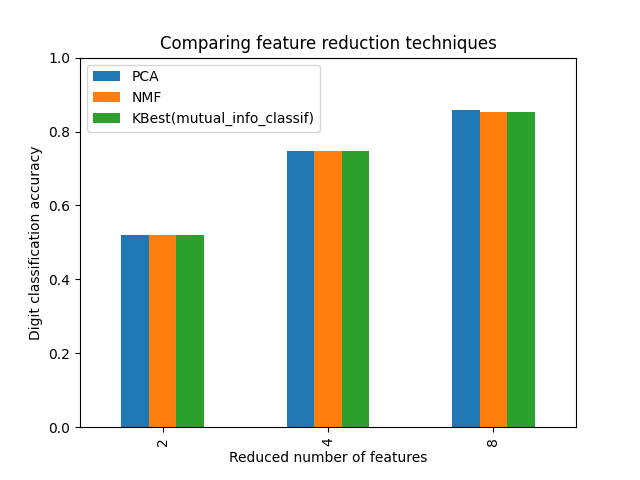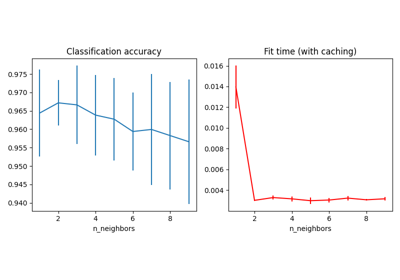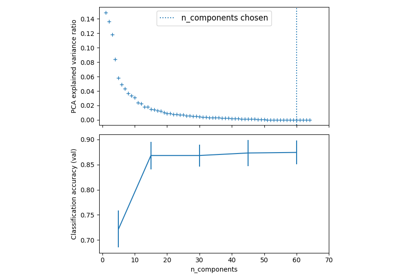Note
Go to the end to download the full example code. or to run this example in your browser via Binder
使用Pipeline和GridSearchCV选择降维方法#
本示例构建了一个管道,先进行降维,然后使用支持向量分类器进行预测。它展示了如何使用 GridSearchCV 和 Pipeline 在一次交叉验证运行中优化不同类别的估计器——在网格搜索期间,无监督的 PCA 和 NMF 降维方法与单变量特征选择进行了比较。
此外,可以使用 memory 参数实例化 Pipeline 以对管道中的转换器进行缓存,避免重复拟合相同的转换器。
请注意,当转换器的拟合成本较高时,使用 memory 启用缓存会变得很有意义。
# 作者:罗伯特·麦吉本
# 乔尔·诺斯曼
# 纪尧姆·勒梅特
Pipeline 和 GridSearchCV 的示例
import matplotlib.pyplot as plt
import numpy as np
from sklearn.datasets import load_digits
from sklearn.decomposition import NMF, PCA
from sklearn.feature_selection import SelectKBest, mutual_info_classif
from sklearn.model_selection import GridSearchCV
from sklearn.pipeline import Pipeline
from sklearn.preprocessing import MinMaxScaler
from sklearn.svm import LinearSVC
X, y = load_digits(return_X_y=True)
pipe = Pipeline(
[
("scaling", MinMaxScaler()),
# reduce_dim阶段由param_grid填充
("reduce_dim", "passthrough"),
("classify", LinearSVC(dual=False, max_iter=10000)),
]
)
N_FEATURES_OPTIONS = [2, 4, 8]
C_OPTIONS = [1, 10, 100, 1000]
param_grid = [
{
"reduce_dim": [PCA(iterated_power=7), NMF(max_iter=1_000)],
"reduce_dim__n_components": N_FEATURES_OPTIONS,
"classify__C": C_OPTIONS,
},
{
"reduce_dim": [SelectKBest(mutual_info_classif)],
"reduce_dim__k": N_FEATURES_OPTIONS,
"classify__C": C_OPTIONS,
},
]
reducer_labels = ["PCA", "NMF", "KBest(mutual_info_classif)"]
grid = GridSearchCV(pipe, n_jobs=1, param_grid=param_grid)
grid.fit(X, y)
import pandas as pd
mean_scores = np.array(grid.cv_results_["mean_test_score"])
# 分数按param_grid迭代的顺序排列,即按字母顺序排列
mean_scores = mean_scores.reshape(len(C_OPTIONS), -1, len(N_FEATURES_OPTIONS))
# 选择最佳C的分数
mean_scores = mean_scores.max(axis=0)
# 创建一个数据框以简化绘图
mean_scores = pd.DataFrame(
mean_scores.T, index=N_FEATURES_OPTIONS, columns=reducer_labels
)
ax = mean_scores.plot.bar()
ax.set_title("Comparing feature reduction techniques")
ax.set_xlabel("Reduced number of features")
ax.set_ylabel("Digit classification accuracy")
ax.set_ylim((0, 1))
ax.legend(loc="upper left")
plt.show()

在 Pipeline 中缓存转换器
有时存储特定转换器的状态是值得的,因为它可能会再次使用。在 GridSearchCV 中使用管道会触发这种情况。因此,我们使用参数 memory 来启用缓存。
请注意,这个例子只是一个说明,因为在这种特定情况下,拟合PCA不一定比加载缓存慢。因此,当变换器的拟合代价较高时,请使用 memory 构造参数。
from shutil import rmtree
from joblib import Memory
# 创建一个临时文件夹来存储流水线的转换器
location = "cachedir"
memory = Memory(location=location, verbose=10)
cached_pipe = Pipeline(
[("reduce_dim", PCA()), ("classify", LinearSVC(dual=False, max_iter=10000))],
memory=memory,
)
# 这次将在网格搜索中使用缓存的管道
# 退出前删除临时缓存
memory.clear(warn=False)
rmtree(location)
PCA 拟合仅在评估 LinearSVC 分类器的第一个 C 参数配置时计算。其他 C 参数配置将触发加载缓存的 PCA 估计器数据,从而节省处理时间。因此,当拟合变换器成本较高时,使用 memory 缓存管道非常有利。
Total running time of the script: (0 minutes 40.968 seconds)
Related examples





